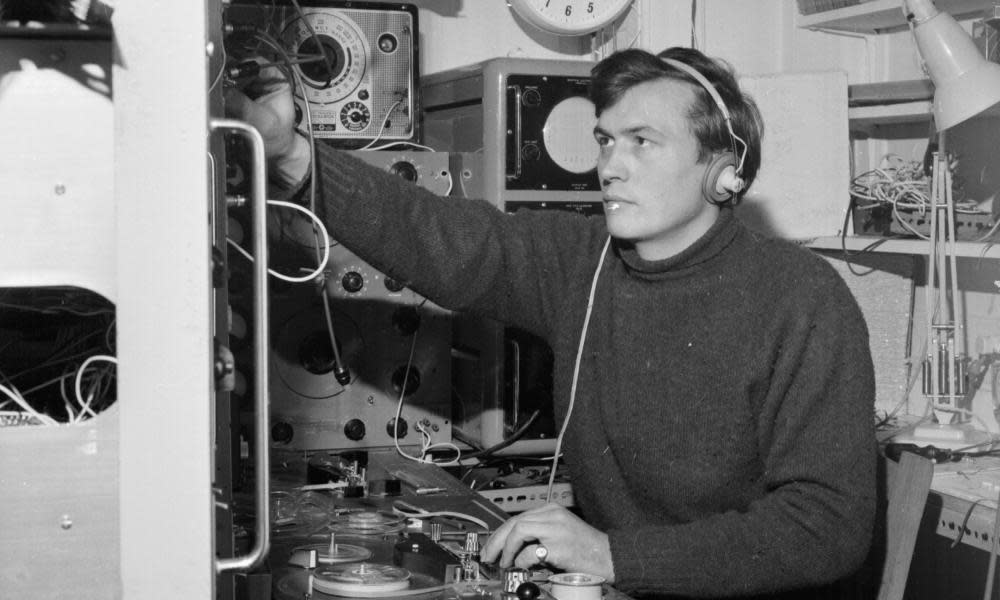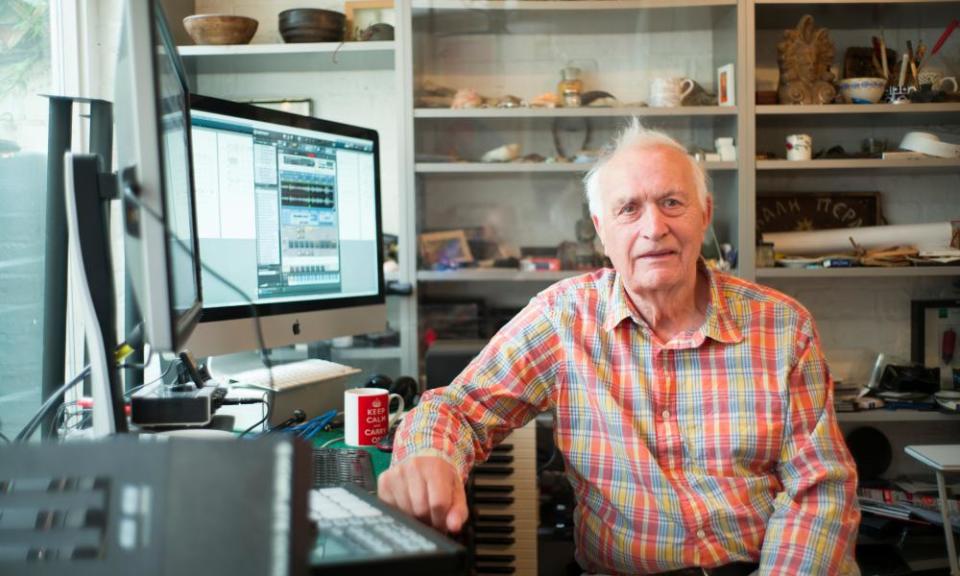Peter Zinovieff obituary

Although the Moog synthesiser became synonymous with electronic music, Peter Zinovieff’s Electronic Music Studios (EMS) deserves equal credit. The VCS3 synthesiser it launched at the end of the 1960s became a favourite creative tool of some of the most adventurous musicians of the era, including Brian Eno, Hawkwind, Robert Fripp, Curved Air, Led Zeppelin, Gong, Roxy Music and Jean-Michel Jarre.
“To me, the original VCS3 synthesiser is like a Stradivarius,” Jarre commented. “All these old analogue instruments are very poetic. I have a huge emotional relationship with them.”
Pete Townshend used the VCS3 to create the pulsing organ track for Won’t Get Fooled Again (from the Who’s 1971 album Who’s Next), while a variant of the machine, the Synthi AKS, featured prominently on Pink Floyd’s Dark Side of the Moon, after the guitarist David Gilmour visited Zinovieff at his Putney home in south-west London.
“He built this thing in his garden shed,” Gilmour reported. “He showed me the original machine, masses of wires and hundreds of components all around the walls, floor to ceiling, which he had miniaturised down to a briefcase model.” Thanks to apeSoft’s iVCS3 app, today’s musicians can use VCS3-like effects on an iPad.
Zinovieff, who has died aged 88, founded EMS in 1965, and it developed into a seething creative hub for electronic music in Britain in the late 60s and 70s. The particular purpose of EMS was, in Zinovieff’s view: “To be able to analyse a sound; put it into sensible musical form on a computer; to be able to manipulate that form and recreate it in a musical way.” EMS became a creative home for such experimentalists as Harrison Birtwistle, Karlheinz Stockhausen and Hans Werner Henze, and its reputation prompted visits from innovators including Ray Dolby and Bob Moog.
Zinovieff had invaluable help from his collaborators, the composer and electronic experimentalist Tristram Cary and David Cockerell, a former medical technician whose expertise helped Zinovieff translate his ideas into reality. “Peter had built up his studio using his own rather amateurish engineering skills,” Cockerell explained. “He really needed someone with a bit more technical competence – well, more patience – than he had, to make the sounds that he had in his head … he was bold and adventurous, and he thought ‘let’s do it’, and he did it.”

In 1966, Zinovieff formed Unit Delta Plus in collaboration with Delia Derbyshire and Brian Hodgson from the BBC Radiophonic Workshop, with the aim of creating electronic music as well as promoting its use in film and TV. In its brief lifespan (it dissolved in 1967), Unit Delta Plus staged supposedly the first concert of British electronic music, at the Watermill theatre in Berkshire. It also took part in the Million Volt Light and Sound Rave in 1967 at the Roundhouse, in London, at which Paul McCartney’s 14-minute sound collage Carnival of Light was aired.
Zinovieff began to find running his studio a financial burden, not least because he had little interest in making profits. “I didn’t want to have a commercial studio, I wanted an experimental studio, where good composers could work and not pay,” he explained. “If anyone had a good project, they could come and work in my studio and I wouldn’t charge them.”
He wrote a letter to the Times offering to donate the studio to the nation, but this attracted scant interest. He and his partners then decided to create a brand of EMS synthesisers to be sold commercially, and their first attempt, in 1969, was the Voltage Controlled Studio 1 (VCS1). This was designed by Cockerell and was sold to the Australian composer Don Banks for £50.
EMS’s console-sized Synthi 100 was used by, among others, the BBC Radiophonic Workshop, who used it to create music for Doctor Who and Blake’s 7. Then came the VCS3, which was designed as a portable electronic music studio rather than just an instrument, and had a keyboard attached. It sold for about £330. It would subsequently evolve through a series of iterations including the Synthi A, the Synthi AK and the Synthi AKS. By the mid-70s, rivals such as Oberheim and Yamaha were threatening to overtake the synthesiser market, but in 1976 EMS scored another coup by introducing the Vocoder voice synthesiser.
Zinovieff was born in London, the son of Leo Zinovieff and his wife, Sofka (nee Sophia Dolgorouky). His parents were Russian aristocrats who met in London after their families had fled their homeland to escape the Russian revolution. Peter and his brother, Ian, spent the second world war living with their grandparents in Guildford, Surrey, and then with their father in Sussex following their parents’ divorce.
After attending Guildford Royal grammar school and Gordonstoun school, in Moray, Scotland, Zinovieff went to Oxford University and took a DPhil in geology. He spent some time in geological exploration in Pakistan and Cyprus before turning his full attention to the electronic music in which he had previously dabbled alongside his academic studies.
He married his first wife, Victoria Heber-Percy, in 1960. The following year he built himself a home studio in a bunker in his garden overlooking the Thames in Putney. “I was lucky in those days to have a rich wife and so we sold her tiara and we swapped it for a computer,” Zinovieff reminisced.
He thus became one of the first people anywhere to install a computer in a private home – it was equipped with a now-inconceivably minuscule four kilobytes of memory, and cost a then astronomical £5,000 to build –and he used it to control his sound-generating equipment. Zinovieff was breaking unknown ground, though he was evidently aware of the work of the computer-music explorers Max Mathews and Jean-Claude Risset at Bell Labs in New Jersey, and of the doctoral research of David Alan Luce (future inventor of the Polymoog synthesiser) at the Massachusetts Institute of Technology.
After EMS collapsed into bankruptcy in 1979, Zinovieff retreated into teaching and working in graphic design, though he wrote the libretto for Birtwistle’s opera The Mask of Orpheus (1986) while living on the island of Raasay in Scotland, where both he and Birtwistle had properties.
He returned to composition in 2010. He collaborated with the violinist Aisha Orazbayeva on OUR (2010) and Our Too (2014), created a series of pieces with the poet Katrina Porteous, and with the cellist Lucy Railton conceived RFG (the title stood for Rowntree’s Fruit Gums). This was performed live in 2016-17, and released as the album RFG Inventions for Cello and Computer in 2020. In 2015, a compilation of his early work was released in 2015, the same year that Anglia Ruskin University awarded him an honorary doctorate of music.
He is survived by his fourth wife, Jenny (nee Jardine), and by six children: Sofka, Leo and Kolinka, from his first marriage, and Freya, Kitty and Eliena, from his second, to Rose Verney; his son Kyril, from his third marriage, to Tanya Richardson, died in 2015. His first three marriages ended in divorce.
• Peter Zinovieff, electronic music innovator and composer, born 26 January 1933; died 23 June 2021

 Yahoo News
Yahoo News 
